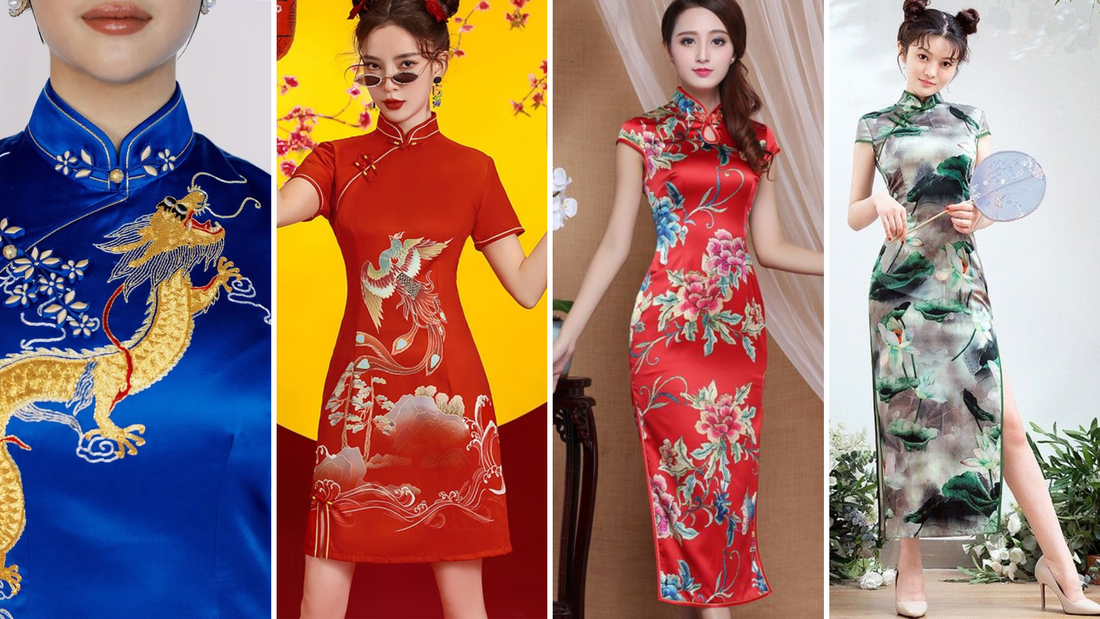
The Symbolism Behind Qipao Patterns: Dragons, Peonies, and Cultural Motifs
Share
Introduction: The Art of Qipao Design
The Qipao, also known as the Cheongsam, is more than just a garment — it is a living canvas of Chinese culture. Beyond its sleek silhouette and elegant tailoring, the patterns and motifs woven or embroidered onto a Qipao carry rich symbolism, reflecting values, beliefs, and cultural stories that have been passed down for centuries. From dragons representing power to peonies symbolizing wealth, each element adds depth and meaning to this iconic dress.
In this article, we explore the symbolism behind traditional Qipao patterns, how these motifs are integrated into modern fashion, and why understanding them can enhance appreciation for this timeless garment.
1. Dragons: Power, Strength, and Luck

The dragon is perhaps the most iconic motif in Chinese culture, and it frequently appears on Qipaos to convey authority, vitality, and auspiciousness. Traditionally, dragons were reserved for emperors, symbolizing supreme power and divine protection.
Design Features:
- Flowing, sinuous forms embroidered in gold or red threads
- Positioned across the shoulders, bodice, or sleeves to create a dynamic, commanding presence
- Often paired with clouds or water waves to amplify the sense of movement and energy
Symbolic Meaning in Modern Qipao Designs:
Dragons are used to signify strength and ambition, making them popular for formal events or special celebrations
Modern Qipao designers often reinterpret dragons using minimalist or abstract designs, balancing tradition with contemporary aesthetics
2. Peonies: Wealth, Beauty, and Prosperity

Peonies, known as the “king of flowers” in China, symbolize wealth, honor, and beauty. Their lush, layered petals make them a favorite motif for elegant and feminine Qipaos.
Design Features:
- Embroidered or printed in soft pastels or vibrant reds
- Large-scale patterns often centered on the bodice or hemline
- Combined with smaller floral elements to create a harmonious composition
Symbolic Meaning in Modern Qipao Designs:
Peonies are versatile and suitable for weddings, formal events, and celebratory occasions
Contemporary designers incorporate watercolor-style peonies, metallic threads, or subtle prints for a modern look while retaining cultural significance
3. Phoenixes: Grace, Virtue, and Renewal

The phoenix is a legendary bird in Chinese mythology, representing virtue, grace, and rebirth. On Qipaos, the phoenix is often paired with the dragon, symbolizing harmony between male and female energies (yin and yang).
Design Features:
- Embroidered with iridescent threads to mimic the bird’s colorful plumage
- Positioned along the back, sleeves, or skirt for a flowing effect
- Often stylized with tail feathers extending across the hemline, adding movement to the dress
Symbolic Meaning in Modern Qipao Designs:
Modern designers sometimes simplify the phoenix into geometric patterns or abstract forms
It is popular in wedding Qipaos, symbolizing a harmonious union and prosperous life
4. Lotus: Purity, Harmony, and Enlightenment

The lotus flower is a spiritual and cultural symbol in China, representing purity, perfection, and enlightenment, as it rises unstained from muddy waters.
Design Features:
- Often embroidered with delicate stitches in soft pastel or white tones
- Used in border designs or scattered across the dress for subtle elegance
- Combined with water motifs for a serene and flowing aesthetic
Symbolic Meaning in Modern Qipao Designs:
The lotus motif is ideal for everyday elegance or office-appropriate Qipaos
Modern designers use laser-cut patterns, subtle prints, or tonal embroidery to maintain refinement while appealing to contemporary tastes
5. Other Traditional Motifs
In addition to dragons, peonies, phoenixes, and lotus flowers, Qipaos often feature:
- Butterflies: Symbolizing love and joy
- Cranes: Representing longevity and wisdom
- Bamboo: Denoting resilience and integrity
- Clouds and Waves: Enhancing the flow of the design and connecting motifs with nature
Each motif carries a layer of cultural storytelling, allowing the wearer to express personality, intention, and heritage through fashion.
6. How Traditional Motifs Influence Modern Qipao Fashion
Modern Qipao designers respect tradition while innovating for contemporary audiences. Here’s how motifs are interpreted today:
Minimalist Embroidery: Simplifying complex patterns for everyday wear without losing cultural essence
Color Innovation: Using soft pastels, metallic threads, or gradient effects instead of classic reds and golds
Fusion with Western Silhouettes: Combining traditional motifs with modern cuts, high slits, or sleeveless designs
Mixed Media: Printing motifs onto silk blends or combining embroidery with digital prints for versatile styling
This ensures that the Qipao remains a fashion-forward garment, appealing to Millennials and Gen Z, while honoring its cultural roots.
7. Why Understanding Qipao Motifs Matters
Knowing the symbolism behind Qipao patterns allows wearers and collectors to:
- Make meaningful fashion choices for weddings, parties, or cultural events
- Appreciate the craftsmanship and storytelling embedded in embroidery and fabric
- Share the rich heritage of Chinese fashion with global audiences
- Inspire new designs that blend tradition with modern aesthetics
Conclusion: Wearing Culture with Elegance
From dragons and peonies to phoenixes and lotus flowers, the patterns on a Qipao tell a story. They are more than decorative—they embody Chinese culture, values, and artistry. Modern Qipao designers continue to reinterpret these motifs, creating garments that are both culturally significant and fashion-forward.
For anyone looking to wear a Qipao with meaning, understanding its motifs is key to celebrating tradition while expressing personal style. Whether it’s a luxurious silk dress adorned with phoenix embroidery or a minimalist lotus-patterned Qipao for casual elegance, the Qipao is truly a living work of art.
Related article:
The Modern Qipao: How Millennials and Gen Z Are Redefining Traditional Chinese Fashion
How to Accessorize Your Qipao: Shoes, Jewelry, and Makeup Pairings
Famous Celebrities Who Rocked the Qipao on Red Carpets
Top 10 Qipao Trends in 2025: Colors, Fabrics, and Patterns
How to Style a Qipao for Every Occasion: Weddings, Parties, and Office
Qipao Evolution: From Traditional Chinese Dress to Modern Fashion Icon
Qipao vs. Cheongsam: Which Style Suits Your Modern Wardrobe?
